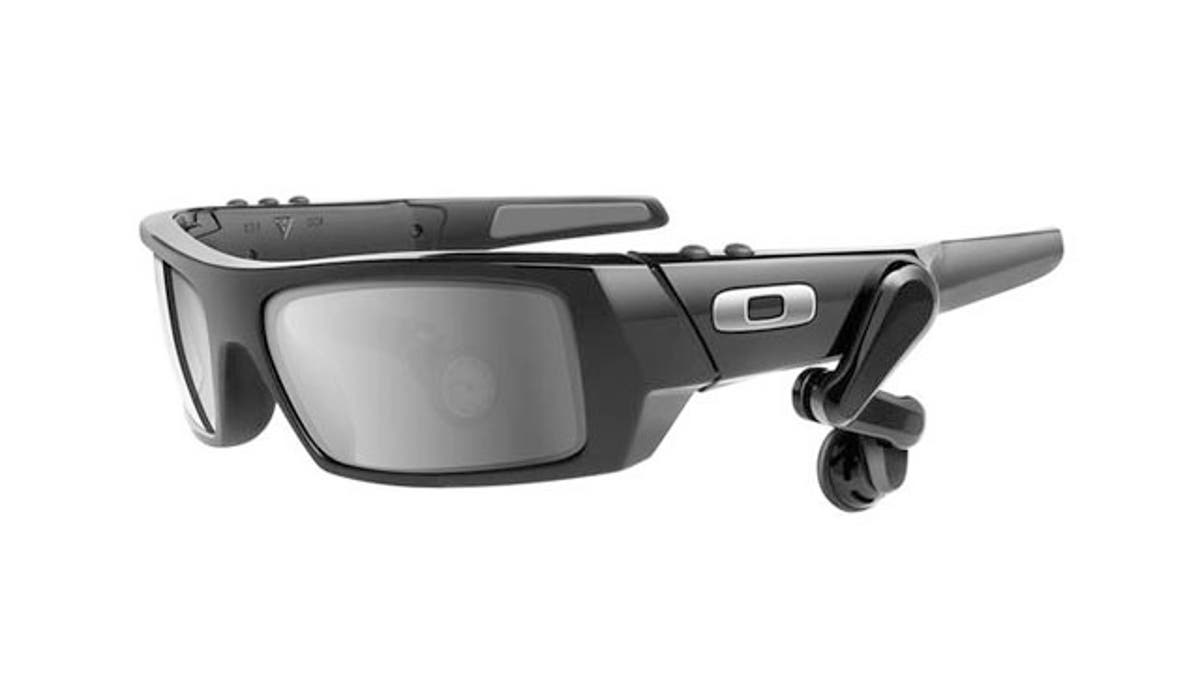
Early reports suggest Google's new glasses will look very similar to a pair of Oakley Thumps. (Oakly)
Digital information right in front of your eyes – sounds cool, right? Not so fast.
Rumors have been circulating across the web about a mysterious prototype of digital goggles being developed by Google. While no official announcement from the software corporation has been made, a report by the New York Times cited various Google employees - who wished to remain anonymous - claiming the goggles would be available by the end of the year.
According to the employees, the glasses will be Android-based and will consist of a small screen that will stream information in real time. A Google spokesman would not confirm the existence of the glasses to FoxNews.com.
However, the screen will only be mere millimeters away from the wearer’s eyes, and this information has sparked debate among optometrists on whether or not these glasses are safe to use. While the goggles may seem like an interesting, innovative device, having a digital screen in such close proximity to a person’s eyeballs could be potentially damaging to their vision.
“Any time we’re utilizing a digital display, computer vision syndrome (CVS) becomes a concern,” Dr. Justin Bazan, an optometrist at Vision Source Park Slope Eye in Brooklyn, N.Y., told FoxNews.com. “CVS is the stress and fatigue we experience on our eyes when we use a digital device for a long period of time. Pixilated images are hard for our eyes to focus on, so when these images are so close to our eyes, our eyes have to turn in towards each other – what is known as convergence – which can cause that same type of eye fatigue.”
Symptoms typically associated with CVS include eye irritation, an inability to keep objects in focus, and sometimes – seeing double.
Bazan admitted his concerns are purely speculative since he hasn’t tested the goggles and doesn’t know for sure how they will operate. But according to the hype surrounding them, Bazan is fairly certain the goggles will utilize a heads-up display (HUD), which – depending on how the images are projected – could be cause for concern.
“If it projects the image on the lens [of the glasses], that’s only a few millimeters in front of our eyes,” Bazan said. “This could be a huge problem for CVS. But if it’s projecting the images on the retina, that will have less of an effect [on the eye], if any at all.”
Most prescription glasses sit at about 12 millimeters away from the eye. Because the lenses in normal glasses are clear, people don’t focus on the lens itself. But if there is an image on the lens, the eye draws its attention to that image and converges.
However, Dr. Michael Ehrenhaus, an optometrist and director of New York Cornea Consultants, said it’s more probable that Google knows not to project images directly on the lens, and the images will appear at a distance from the eyes.
“If it’s projected at a distance in front of you, the only strain I would think of would be constant eye movement and dry eye from the eyes being open more often,” Ehrenhaus told FoxNews.com. “I don’t think the printout will be on the inside of the glasses. It would make much more sense the other way around. But there should be almost no strain if the image is being projected at a distance.”
Ehrenhaus also said that given Google’s potential demographic for the glasses, there’s even less concern for strain.
“Younger people should not necessarily have a problem if they have 20/20 vision,” Ehrenhaus said. “And if it’s going to be designed to be worn over glasses, I don’t think there will be excessive eye strain.”
The biggest health concern for Ehrenhaus doesn’t even involve vision, but a person’s physical health. He hopes that people won’t wear them when they’re out in public, as they could make someone more accident prone.
“[Like that] clip about a woman texting and walking, and … [she] fell into a fountain at a mall,” Ehrenhaus joked.
Bazan said that regardless of how the glasses turn out, it’s important to educate consumers about CVS and for them to know the “20-20-20 rule.” The rule maintains that for every 20 minutes that you use a computer device, take a 20 second break and focus on an object 20 feet away.
“It allows our eyes to do something other than that demanding task,” Bazan said. “If I asked you to hold your arms out all day long, they’d be very tired and sore. The same thing happens with our eyes and the convergence system.”
But right now, there’s no firm evidence that these goggles even exist, let alone the type of interface Google uses.
So until an actual “Google goggle” emerges, the only eye strain people will get is from reading Internet blogs about the exciting new device.
